Multimedia itineraries
Mountain in Motion
Multimedia itineraries through the Southern Alps.
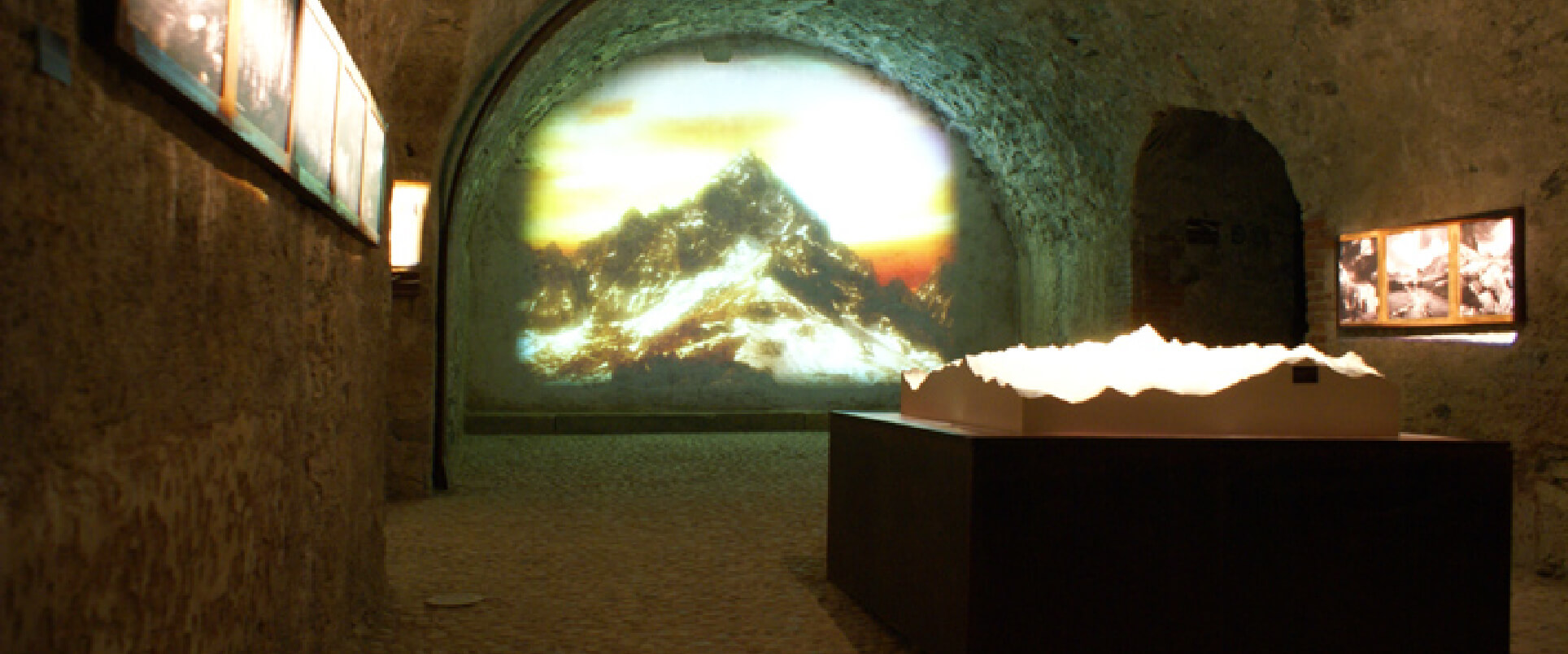
Introduction
We would like to invite you on a journey through space and time. Along the corridors and various rooms of this fortress which no longer hosts men and weapons. We would to tell you about the history of the Southern Alps which are also called Maritime because of their close to the sea.
Why do people often refer to this place as a suburb?
Why do people often think that this mountain is isolated, immobile, marginal or even closed?
We are going to tell a totally different story: how it used to be and still is a place of a continuous and fruitful coming and going of peoples, a point of departure and arrival for ideas, arts, crafts, goods, innovations ...
Today, we are misled to think that metropolises or cities are "the centre", while all the rest is considered "the periphery", but it hasn’t always been like this though. Over the past centuries, in fact, the Alps were not only a centre of exchanges and trades but also the heart of a civilization project able to make a difficult environment adapt to human and social needs and then able adapt to it itself. The mountain has often had a "central" role in history, not as a frontier but as a hinge and an exchange hub.
We will tell you facts and curiosities of this alpine world, as we believe that it has in its historical DNA the ability to grant itself a new future remaining what it has always been like: a mountain in motion.
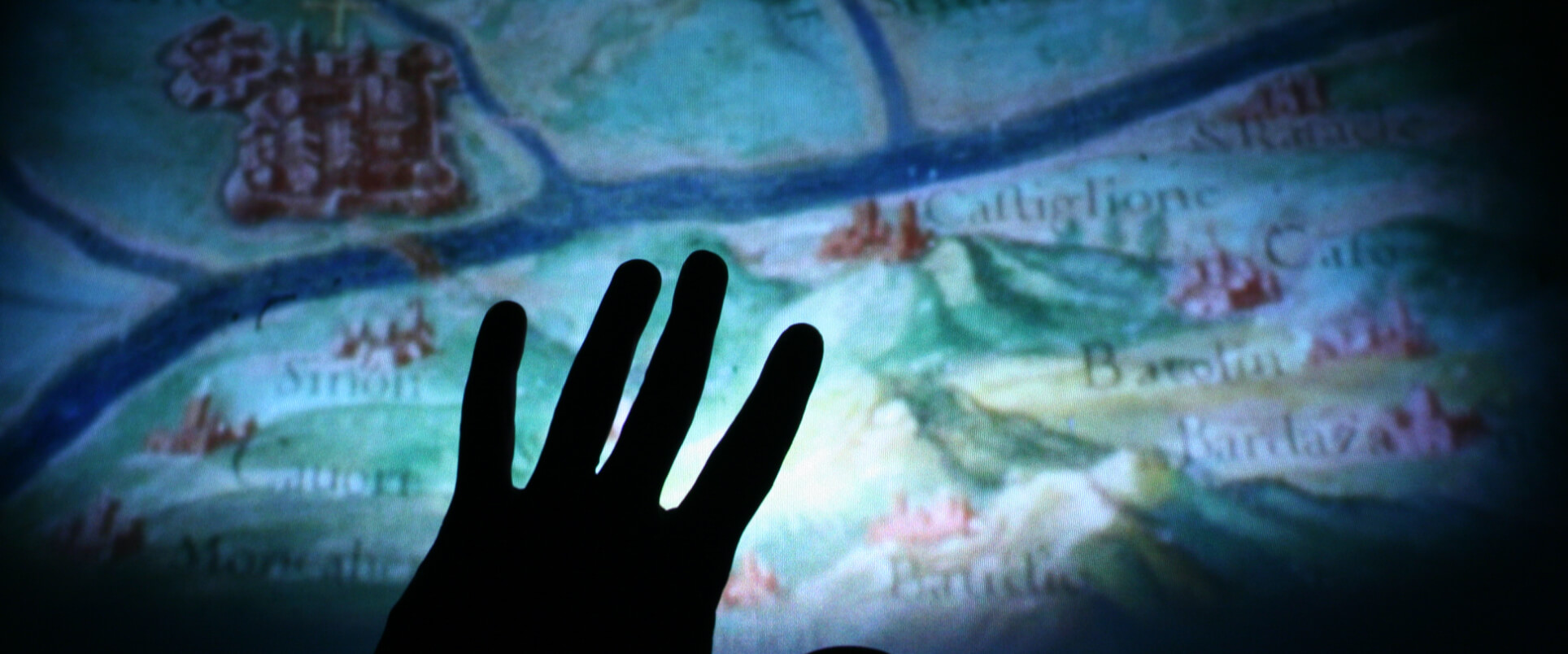
The name Maritime Alps is a simple way to call a land of encounter and crossing located between the sea and the mountains, the North and the South, Mediterranean countries and transalpine ones, the Po valley (i.e. crossed by the river Po) and the Rhone ones (which flows just beyond the Alps, into the great delta of the Camargue). Since the nineteenth century, we have been inclined to think of the Alps as a marginal, border territory but it hasn't always been this way.
In the past the Alps were a strategic and extremely delicate space being located right in the centre of Europe, in fact for centuries this territory was continuously crossed by armies, traders, pilgrims and travellers.
The inhabitants of these Alps never considered themselves as a marginal population, distant and marginalized from the big cities and the plain. They had very strong relationships with the surrounding territories and were able to develop specific life and cultural models.
Today, if we want to put the Alps back to their central position, we have to make an effort and use our imagination. We should forget the national borders that have played such an important role in the history and tragedies of the last century, and rethink the position and strategic role that the Alpine chain has always covered in the European affairs along a process that runs parallel to the path towards the European unification.
This is a new strategic dimension of the Alps, which should be no longer measured with the offense and defence opportunities in case of war, but in terms of conservation and enhancement of its environmental and cultural biodiversity, its natural heritage, historic habitat, clear water and air, language and traditions.
In this way the Alps can gain back their "borderland" role being a dynamic place of research and experimentation characterised by practices and life models enhancing a sustainable future.
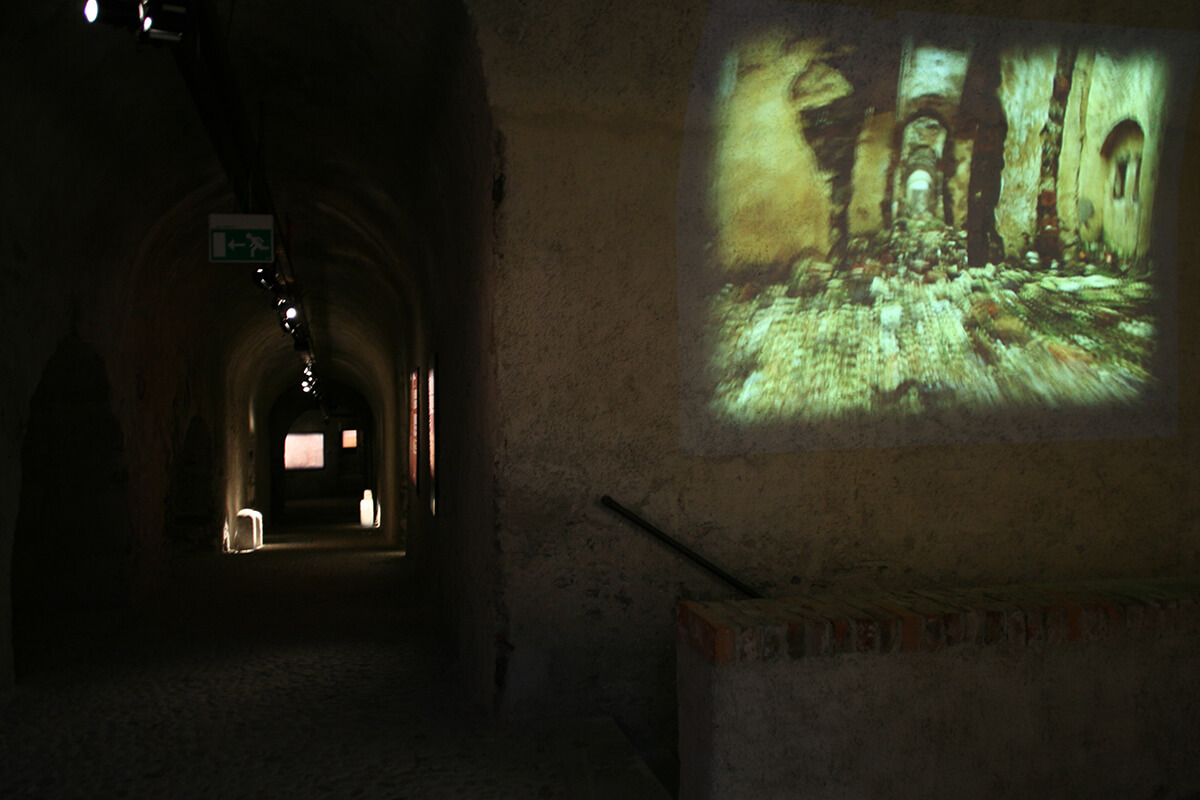
A moving border
In the long corridor that leads to the exhibition, there are several border stones that used to delimit the territory. Occitan musical suggestions, voices, songs and sounds of these mountains move around in space accompanying the visitors. At the end of the corridor, on a multimedia lectern, ancient maps are unrolled and animated thus recreating the historical-graphic flow of the movements of the western alpine border.
Independent memory
Most of the statutes of the Alpine municipalities, which were organized by the local lords, date back to the 14th and 15th centuries. In a small room the statute of Vinadio is reproduced hanging unrolled in the form of a parchment together with the statute of Limone Piemonte which is drawn up in book format.
Speaking “nosto modo”
A large niche in the stone wall turns into a projection surface. Different faces emerge in turns and pronounce words in their own language, Occitan or Provençal. This is "nosto modo", our way to talk and it becomes the starting point, the first access key to the understanding of the culture of this area. Over forty Italian words area said in the spoken language of each valley.
The Monviso, with its triangular silhouette is the symbol mountain of these valleys. From its altitude it dominates not only ridge lines, rocky peaks, moraine circuses, glaciers and snowfields, high altitude grasslands, woods, cones, streams, tongues of alluvial origin in the valley floor but also villages, mule tracks, canals, farms, stone terraces, meadows, temporary settlements for pastures, religious and military constructions, paths across hills, towns of the valley floor.
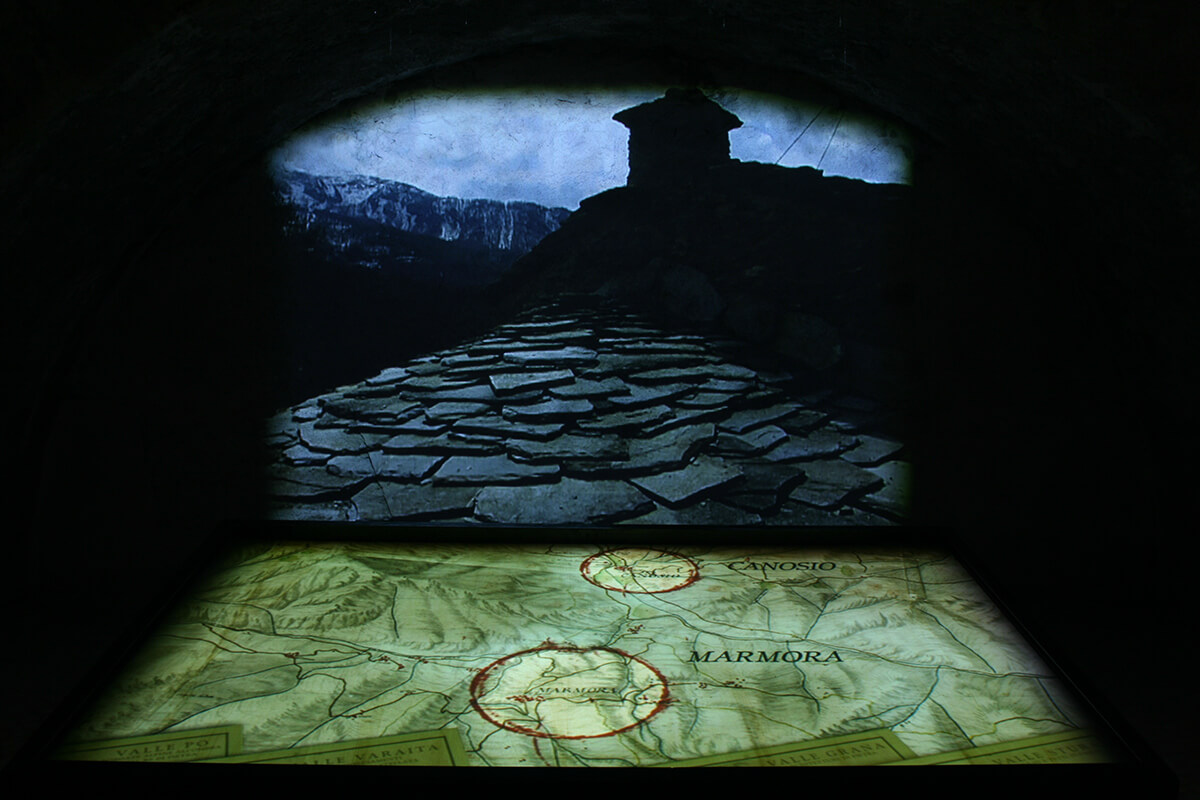
Compared to the horizontal and homogeneous territories of the plain, where the individual landscape units cover large areas, the mountain offers a variety of extremely different and articulated contexts as well as environmental situations. In order to be able to live in this area, man had to understand and interpret it, starting a process of slow and constant modification of the environment that spanned over centuries and millennia modifying the environment not against nature, but in synergy with it. The result is a landscape in which nature and anthropic interventions, rather than being in opposition, integrate and come together. Because the traditional ways of life have disappeared, today it difficult to recognize the signs and meanings of that landscape built with enormous effort, layer after layer, over time. A landscape that has certainly set the scene of small or large tragedies, wars between armies or religions. Yet that landscape tells first of all about a relationship between men and nature, the very one that we need so much today. A landscape that needs to be read and understood again in order to rethink our way of relating to the environment around us.
A vertical landscape
Three video projections develop a single large natural scenario that unfolds from the ground to the walls to reveal the mountain in all its beauty and majesty from the valley floor to the summit. Fire, water, wind and earth continually redesign its landscape, accompany the changing seasons and day and night alternation. A carpet of leaves, mushrooms and damp earth turns into a blanket of snow and ice, a green lawn and a rye field. Climbing up the steps leading to the upper floor, you cross the images of the villages and pastures until you reach the top of the Monviso, which shows itself unchanging, inert to the seasons. The different altimetric bands that characterize this landscape are presented in details on the multimedia lectern.
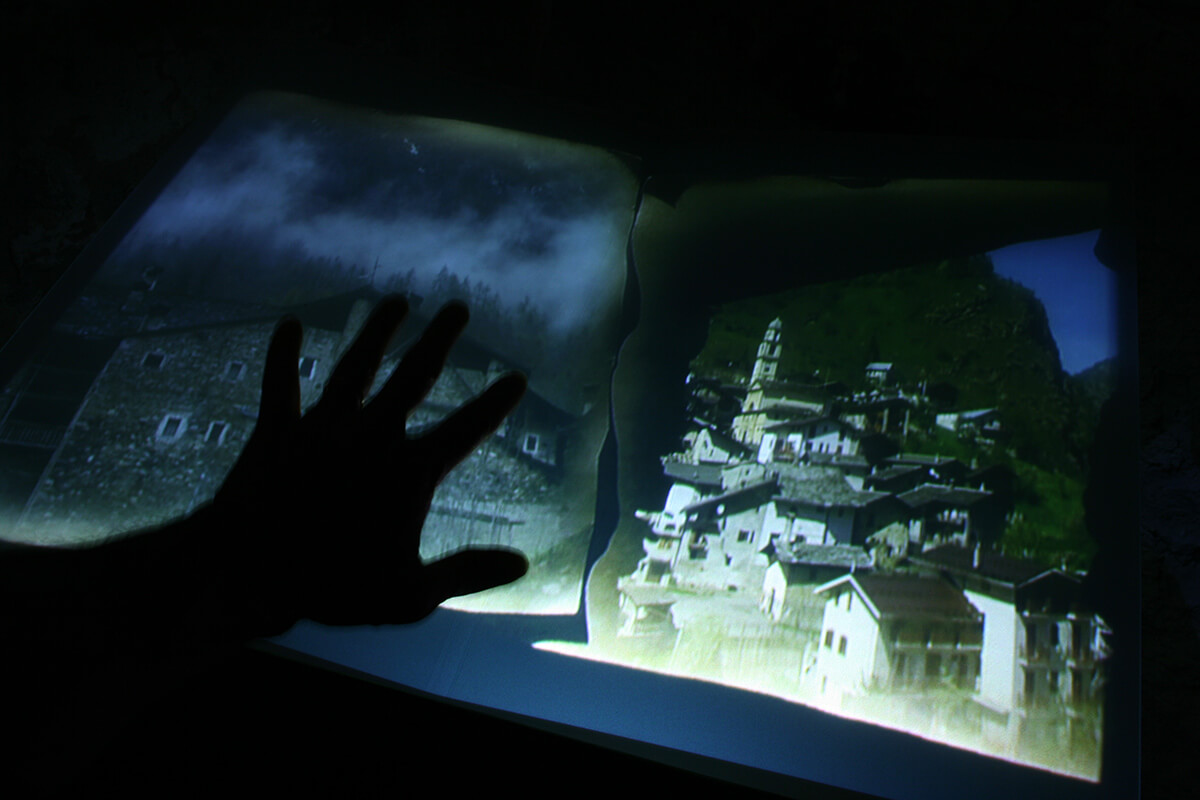
A built landscape
There is a table in the centre of the room and some digital images of different eighteenth-century maps are placed on it. When a visitor’s hand reaches them, the cards light up and get carried away, begin to flow through the valleys in search of the different settlements that mark this territory. Touching the image of one of these villages, the opposite wall lights up and the moving images retrace an ideal approach from the overall valley landscape to the details of the individual architectures.
The rural settlement
On the multimedia lectern, diagrams and video images deepen the relationship between the morphology of the territory and its constructive interpretation by the local communities.
Alpine towns and Romanesque - Gothic architecture
There is a table in the centre of the room and some images of ancient illustrations are placed there to depict the heritage of the civil and religious architecture of Cuneo’s valleys.
When a hand is placed on one of these pictures, the watermark fades, becomes almost transparent and a glimpse of a current video image of the same building today appears. Continuing to "dust off", the ink strokes slowly fade away and the story begins. After a few minutes the sheet slips away and a new illustration comes in.
The salt roads - Il Buco di Viso (The Viso hole)
Step by step a "subjective" video traces the seventy-five meters of the Buco di Viso in the rock, all the way up to France. On the ground in front of it, an ancient map marks the paths of the salt routes.
Adrech and ubac
Visitor walk through the room squeezed between two large inclined video projections. These are just like the two sides of a valley. In the meantime, two synchronized aerial panoramas go up the valley, the sound vibrations accompany the landscape which are on the one hand warm but cold on the other.
Some rather widespread stereotypes suggest the Alps as being characterised by immobility and backwardness, but in reality the mountain is and has always been in motion. Wide-ranging mobility is in fact an essential component of the Alpine society. Over the centuries transhumance and periodic migrations have ensured the connection of these valleys with the plains, the metropolises and even distant regions. Those who temporarily abandoned their valleys were not only, or mainly forced to leave because they needed to but they often had skills, a job and networks of relationships that the long tradition of mobility of this region had allowed to consolidate. These people generally did not set off by chance with no clear destination, but had a social and cultural compass that directed their migrations. The reference space of the Alpine communities was thus wider than their territory. Each village had its own diaspora, and robust centripetal forces which, year after year, marked the seasonal returns.
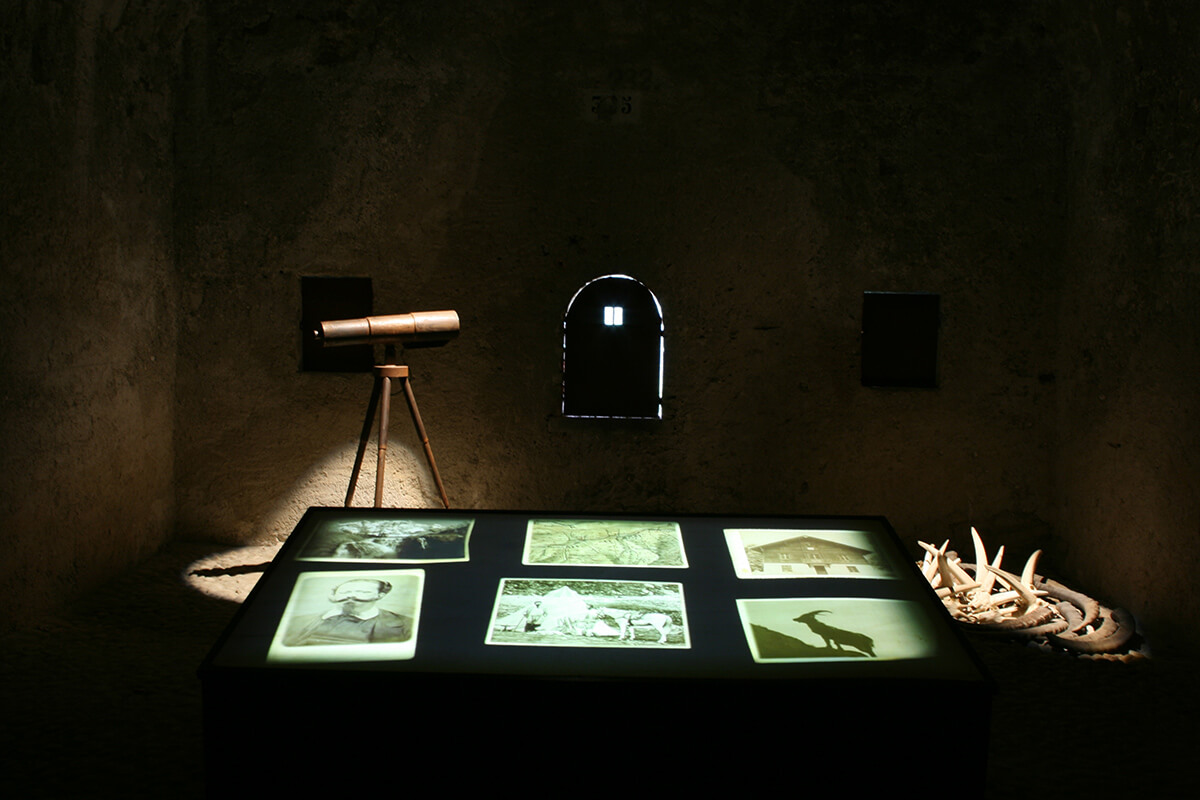
In addition to "exporting" an important share of its population, the mountain has been far from impervious to external incursions. In the past the Alps have been constantly crossed by soldiers, artists, traders, pilgrims: a varied crowd that has left conspicuous traces in the landscape and culture of the valleys. In recent centuries, the mountain has been "discovered" and appropriated by an urban elite who travelled and reinvented it, in search of regenerating waters, wild prey and unexplored peaks. The valleys are thus transformed into a place of leisure, where one can seek contact with a primeval, natural, intact world. These are the forerunners of today's mass tourism.
From the mountain to the plain
Three large wicker baskets rest on the ground and define the space around them. When the visitor’s hands discover the material of the basket, their touch turns it into a container for a video story. On a light gauze inside the basket some images emerge: the hands of the anciué (the anchovy sellers), caviè (hair collectors), coopers, knife sharpeners, violet pickers; they fill and empty the basket, from time to time, with anchovies, hair, straw, wood, medicinal herbs, work tools. On the lectern, as if leafing through a virtual photo album, at the visitor’s touch the motionless images of elderly faces are activated and tell their stories of itinerant and seasonal workers.
Transhumance
A raw wool carpet lies at the centre of the room and supports the video images.
A cloud of collars and cowbells is suspended from the ceiling. If the visitor makes one vibrate, the echo of the shepherds' calls reverberates in space; a flock of sheep starts moving, as in an ideal transhumance path, slowly crosses the entire carpet. On the lectern-album the words and faces of elderly shepherds alternate to tell about this ancient work.
The rediscovered community: the return
Among clothes and masks of the Alpine ritual, a large screen of ribbons hangs displaying the festival of Baio in Sampeyre and other traditional ones. Screams, music, bells and drums set the pace for the march. Suddenly everything stops, the close-up images of ribbons, cockades, details of costumes, faces, hats recompose the portraits of the characters of the baio: serazine, tambourin, sapeur , abà ... the procession resumes its journey ... On the lectern, scholars and witnesses from different villages tell about the tradition of religious festivals, baio, and how weddings took place.
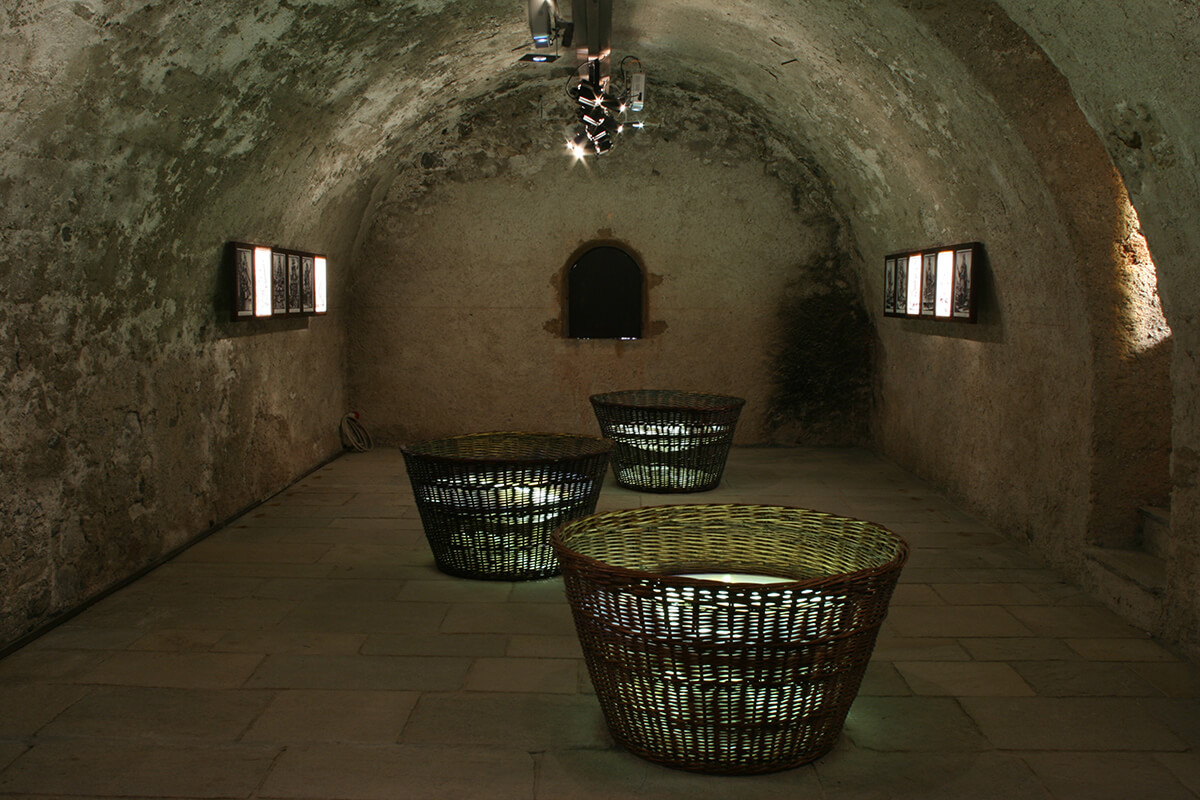
Steps of art
A dusty table stands in the centre of the room. Slightly touching the surface, the dust rises and the image of a candle lights up on the wall all around, a fresco gradually emerges and the light moving above explores the details of the painting while the images lying on the table and the information about some Gothic painters complete the story. On the lectern, the images of the paintings left on the houses facades and votive pillars recompose the history and movements in time of the itinerant painters: Boneto, Borgna and Gauteri.
The roads of faith
A frame hangs in front of a wall dotted with small votive paintings; the pilgrims’ faces come forward in line in transparency; prayers, tales of graces received, religious hymns move in space accompanying an infinite procession. The numerous sanctuaries that characterise the territory are rediscovered on the lectern following a pilgrim’s journey.
Hunting and spas
There are several postcards and old photographs of King Victor Emmanuel and touching one of them, it enlarges to tell short anecdotes and events of the king, the royal hunting reserve and how it was turned into a natural park. An old hunting rifle scope is pointed towards the external landscape: a viewfinder begins to search the area in search of prey; as soon as it manages to focus it, the animal runs away, merging into the trees.
On the lectern, the theme of the waters and spas in the various valleys is presented in depth.
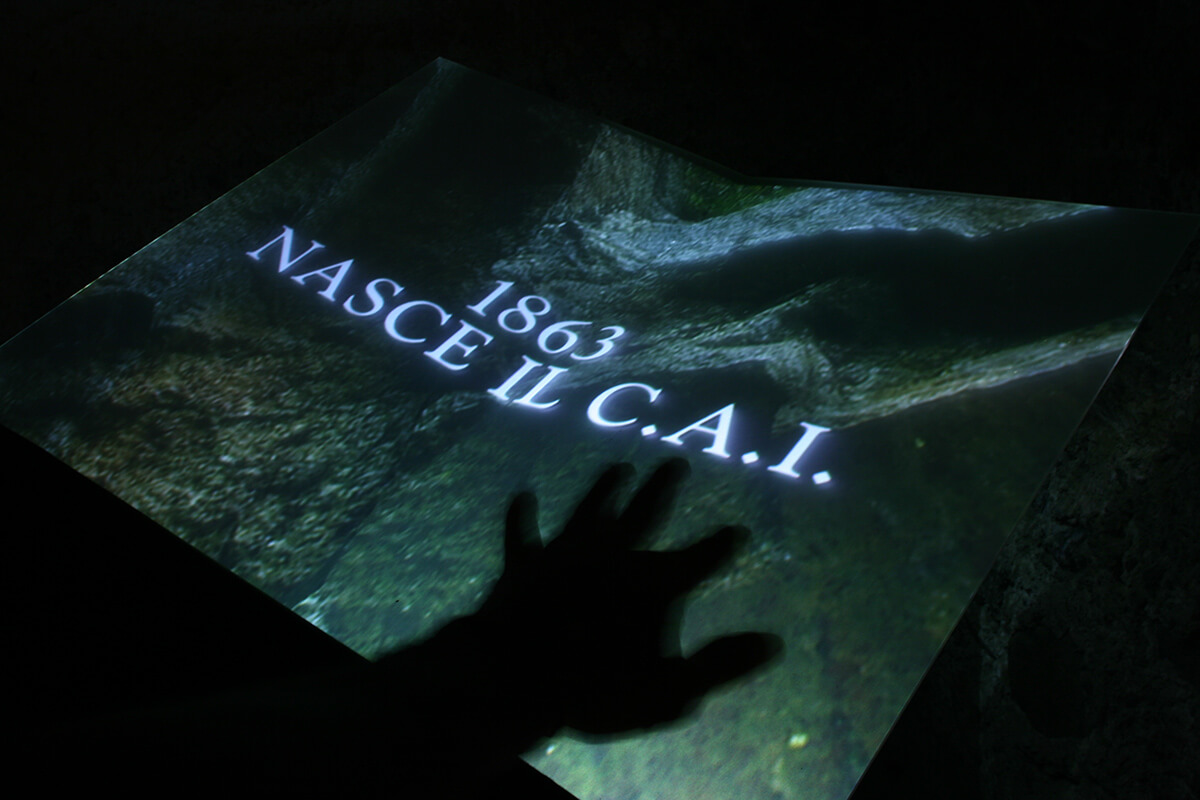
Mountaineering and the birth of the Italian Alpine Club
A single long alpine landscape develops through eight small suspended screens. The motionless and silent mountaintops, stimulated by the visitors approaching, begin to tell their story. The climb of Monviso in 1863, the birth of the Italian Alpine Club, the events of Count De Cessole in the Maritime Alps become the fundamental stages of this narrative. On the lectern, through the writings by Quintino Sella and the photos of the first mountaineers, the birth of the Italian Alpine Club (CAI) is illustrated.
Contraband
Several empty backpacks, once used to carry contraband goods, are illuminated in the centre of the room. When you get closer, the light goes out and a nocturnal journey through the Alps and its borders is projected on the wall while the rhythm of the steps and breathlessness intertwines with the old smugglers’ stories.
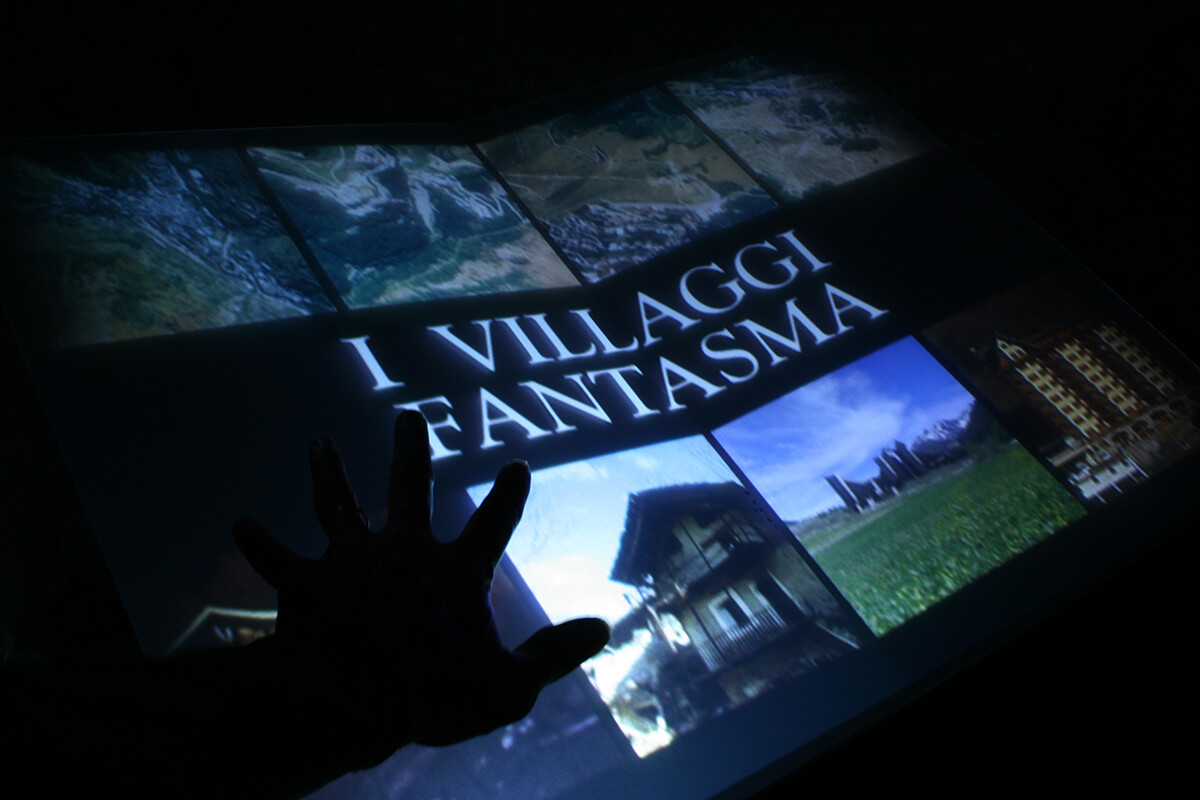
The crisis and then the end of the traditional Alpine civilization is a process that takes place slowly through successive stages. In this area this process plummeted in the early sixties, when agriculture was completely abandoned in the mountains and also as a result of migrations which led to the depopulation of entire valleys and hundreds of villages. This had a dramatic effect in all the southern Alps more than in the rest of the alpine arc. The abandonment of farming has disruptive social, economic and environmental effects. With the loss of the agricultural practice the mountain loses those who had ensured its maintenance for centuries and the effects of this are devastating even in the plains with increasingly frequent and disastrous floods. But the worst is that this is the end of a civilization able to create an extraordinary balance between nature and human needs, between the need to exploit resources and the careful attention not to exhaust them, between environment and built landscape. Today, behind the screen of a misunderstood "modernity", this balance is shattered, there is nothing or no one to defend the alpine landscape, which is sacked, distorted, sometimes cancelled by mass tourism, by purely speculative settlements and by the abandonment of the mountaineers to their fate as new workers who emigrated to the plains for good.
The vanquished world is not a writer’s invention: it is the photograph of Cuneo’s mountains from the mid-sixties to ..….it is difficult to say when the agony will begin to regress and the dying mountain will give its first signs of recovery.
The twentieth century wars
An endless ribbon runs along the cannon staircase and on its surface the names of the fallen of Cuneo’s valleys during the first and second world wars are engraved. The only sounds are the stories, extracted from Nuto Revelli’s interviews.
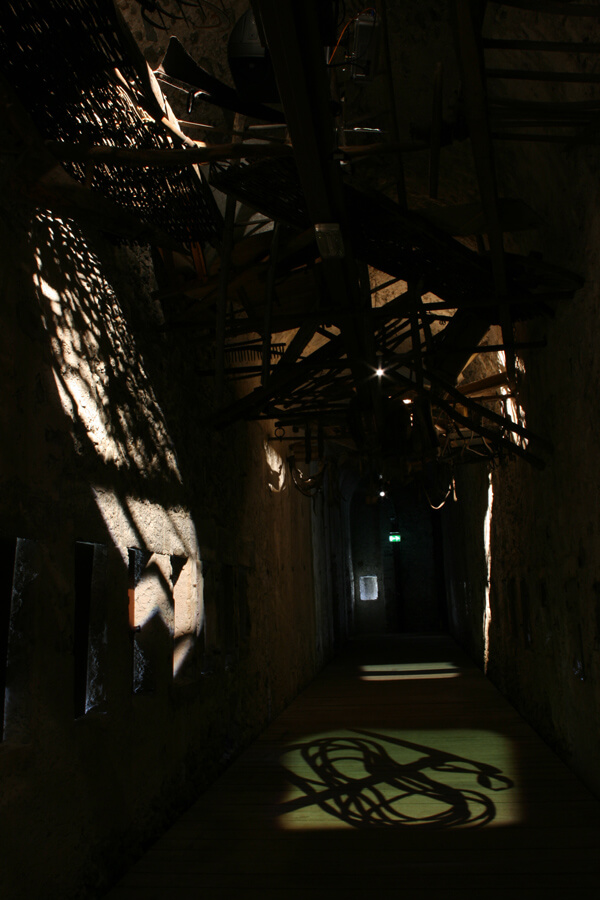
Shadows
In this very long corridor a large number of objects are suspended as material symbols of the ancient peasant civilization of the Alps. The lighting, almost a backlight, highlights its silhouette and creates an intertwining of shadows on the floor and walls. In some places these shadows are activated when a visitor passes by and they seem to come alive: the wheel of a cart starts to turn, a chair overturns, a pan empties onto the floor ... Stories, ancient nursery rhymes and legends create a background sound that discreetly moves around the space.
Emigration without return
Six monitors descend from above along the walls and frame as many portraits. One by one, the elderly and silent faces come alive and tell their stories. Their words become memory shots that describe an emigration without return; the stories of life in the factory so mixed with the memory of life in the township before leaving. In the lectern, the depopulation figures accompany the images of abandonment and isolation.
Territorial infrastructure
Three transparent glass slabs stand cross the space of the room. On the ground, at the foot of each slab, the images of the tracks of a moving train flow, a road travelled, the flow of water in a forced conduit. Approaching one of the slabs, this turns opaque and images and the stories of those projects and infrastructures that have changed the territory emerge: the hydroelectric plants of the Gesso valley, the Cuneo-Nice railway, the Tenda tunnel.
Various hydroelectric plants of the area are analysed on the lectern.
Mass tourism
In front of a transparent screen and in the centre a long wooden platform, a suspended screen frames the image of a mountain landscape at dawn. When a visitor approaches, their footsteps resound on the platform and in the surrounding space: this noise interrupts the stillness of the mountain. It triggers a second projection and suddenly a horde of tourists enters a field, crosses streets, climbs and lies down to sunbathe. The visitor stops and suddenly everything returns to the initial stasis, another scenario is prepared. On the lectern, the images of the ancient Alpine villages now abounded flow together with those of the tourist centres in disuse or uninhabited during low season.
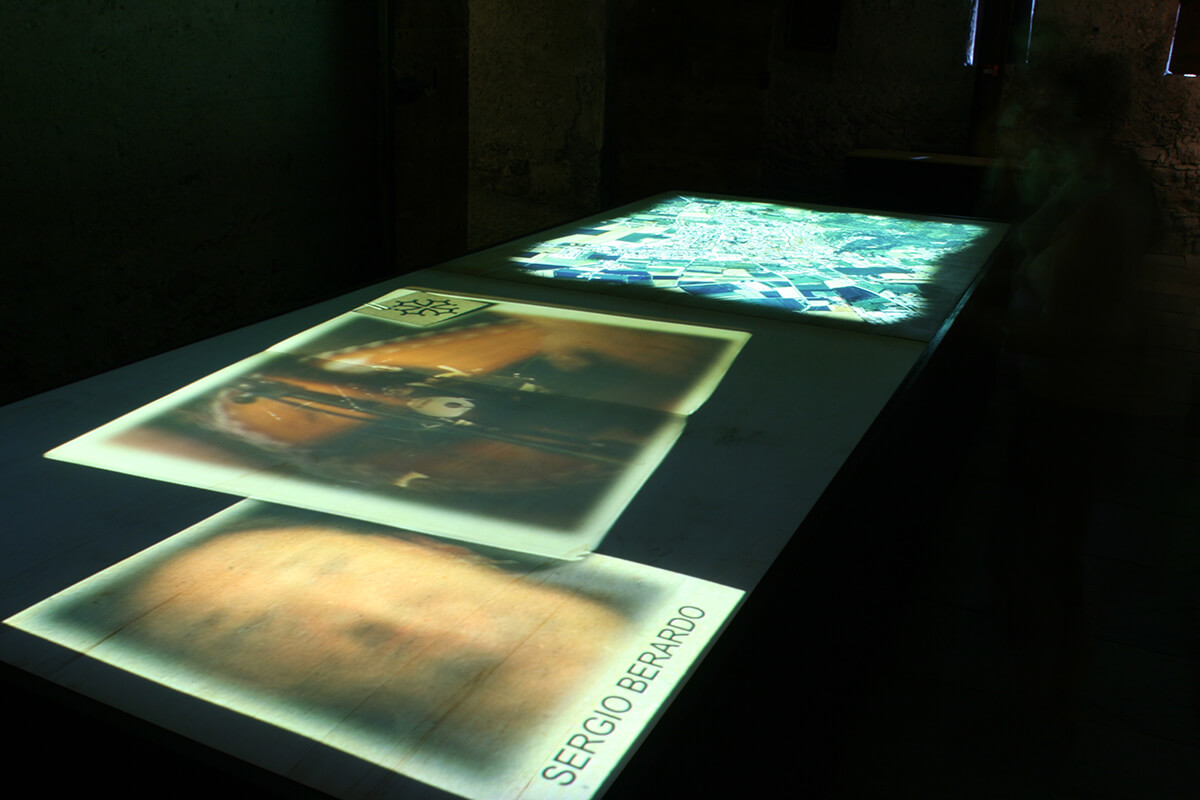
Today the myriad of small ski resorts in Cuneo are weak in the face of an increasingly demanding and globalized winter tourism market, which is threatened by the lack of snow. The limited size of the domaines skiables, the often obsolete systems, the environmental setting that is not always irresistible, the availability of aprés ski activities make the future of many of these places very uncertain, and in any case destined to a "niche" market. Only Limone Piemonte, with its ski park, a historic centre recently undergoing redevelopment and an estimated 25,000 beds - almost all of which in second homes - seems capable of holding its own against the fierce French and Valsusine stations.
Fortunately, with the crisis of the tourism model based on mass skiing, new softer, greener and cultural tourism practices have emerged. Diversified forms of summer and winter holidays, which look at a sustainable future and a different development model for the valleys.
Paradoxically, the valleys that during the twentieth century were most subject to depopulation and abandonment (Stura, Maira, Grana), the same valleys that were the subject of Nuto Revelli 's heartfelt denunciation in the world of the vanquished, can deal with more cultural and environmental resources for their reconversion towards a "milder" and eco-sustainable tourism, while in the high valleys conquered by the ski industry (often with bankruptcy investments such as Argentera, Montoso or Sampeyre) tourism covers towns and inhabitants with a patina of fake well-being, risking to take away from them a part of their most precious wealth: their Alpine identity. If the Alps become a substitute for the plains, they will lose their role in the heart of Europe.
Vinadio Virtual Reality
Vinadio Virtual Reality is part of the project “Altre Visioni, Alte Storie” which in 2017 won the "Polo del '900: bando per il Piemonte" promoted by the Compagnia di San Paolo.
The permanent Vinadio Virtual Reality installation was designed with the purpose to narrate the history of an extremely particular territory, the mountains, through the use of innovative multimedia languages.
Free flight on the Fortress
This is a unique and exciting experience of a free flight over and around the Fortress of Vinadio, with the possibility of admiring the entire building from a new point of view, also thanks to the shooting of a drone.
This flight allows you to discover the details and anecdotes about fortress architectural spaces, which were very often adapted and particularly popular among the population and soldiers during the Great War period.
The flight is accompanied by a series of stories, precious testimonies of Vinadio’s inhabitants who experienced the fortress as a place of refuge, aggregation and sometimes even celebration.
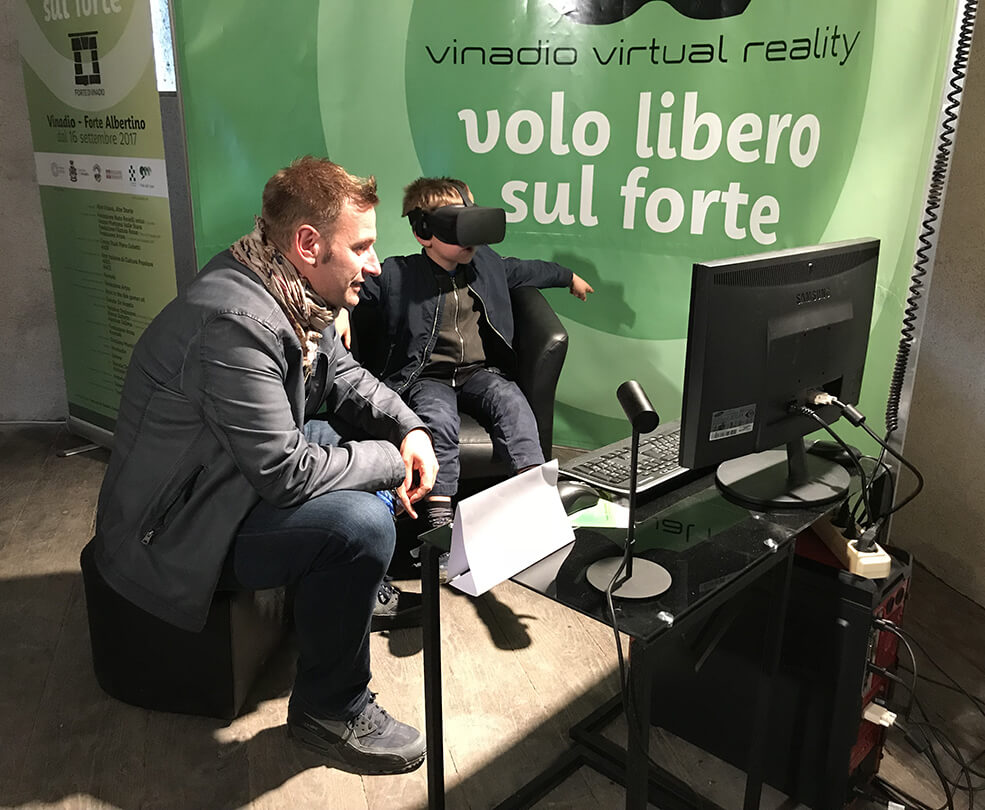
Giallo Forte. A Fortress Thriller
A spy story is the basis of this virtual reality experience.
A real international intrigue that leads the visitor to discover the fortress with the guidance of the narrative voice of an "indicted" officer. This thriller experience was inspired by the discovery of some photographs taken at the end of the nineteenth century by a garrison officer at the fortress of Vinadio. These photographs were discovered in the military archives of the Château de Vincennes in Paris.
And from this starting point the spy story unfolds. Why did those photos end up in the hands of the French?Come and find out! The station, promoted by the Unione Montana Valle Stura, was built with the contribution of the CRT Foundation (Bando Esponente 2017).

